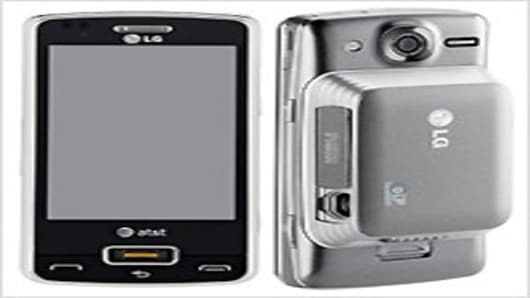Even so, the possibilities are tantalizing. On a plane flight, you’re not doomed to watch your movie on some three-inch iPod screen; you can use the seat back or even the ceiling as your screen. On a campout, you can review the day’s photos on your tent wall. In the elevator, you can do an impromptu PowerPoint pitch for the big financier. At home in bed, you can turn off the lights, point the thing straight up and enjoy a huge, bright image on the ceiling.
Well, it’s 2010, and time for the second wave of pico projectors. (Incidentally, pronunciation is critical. On a TV show last year, I referred to one of the earliest models, the Optoma Pico, as the “op-TOE-ma PIE-ko.” A P.R. person gently corrected me afterward — it’s “OPT-im-a PEEK-o.” Oops.)
There are two “peeko” trends to watch in 2010: cellphones with projectors built in and projectors that use lasers for better brightness and clarity. In this country, the LG Expo is the first of the former, and the Aaxa L1 is the first of the latter.
Now, I don’t know which LG executive agreed to release the Expo, but let’s just hope that he’s found more satisfying employment working at, say, a chicken farm. I can’t remember a more frustrating phone. It’s supposed to be a business phone that runs Windows Mobile 6.5 (yeah, uh-oh). Inside, it’s a nice machine: $200 after rebate with AT&T contract, slide-out thumb keyboard (big, but flat and slippery), Wi-Fi, Bluetooth, GPS, 5-megapixel autofocus camera, works with Microsoft Office documents — the works.
Unfortunately, that sweet phone is trapped behind a touch screen that’s balkier than a burro with mood swings. You try to scroll a list by dragging your finger up the glass — nothing moves. Three, four, five times. So you press a little harder, and now the list moves, but as soon as you lift your finger, it snaps back to where it was!
The frustration is compounded by the software design; many of the onscreen elements are too tiny to tap with your finger. So what does LG do? They give you a stylus.
A stylus? What is this, 1996?
Worse, there’s no place to keep the stylus — no little silo, pocket or groove where it can clip on or slide in, as in the old PalmPilot days. You’ll lose the stylus in three days, but it won’t much matter; by then, you’ll have thrown the phone through the window.
There’s a fingerprint reader below the screen, providing “biometric security” (good luck figuring out how, though — the manual doesn’t even mention it). But you can also swipe your finger on it to scroll the screen.
But this, too, is balky. Press too lightly, and nothing registers; press too hard, and you wind up clicking, setting off a function you didn’t intend.
All right, I know. Who cares, when this thing has a built-in projector?
Actually, it’s not built in. It’s a $180 attachment. You take off the battery door and replace it with the projector apparatus, a square hump the size of a small brownie.
A dire warning fills the phone’s screen: “You can change screen layout with pressing camera key at any time. While Pico projector is on, camera function cannot be supported.” Nice English there, LG.
You can project whatever is on the phone’s screen: your e-mail, the Start menu, the dialing pad — or, more usefully, movies, photos and PowerPoint slides.
The projector puts out only 5 lumens — that’s half the brightness of current pico projectors, and a pico-fraction of the 2,000 lumens put out by a boardroom projector. Still, in a dark room, that’d be enough to give you a four-foot picture on the wall — if you could back up far enough. But you can’t, because no matter what you do with the focus slider, the Expo’s image goes out of focus if you back up farther than about a yard. So the maximum clear image is only about 30 inches diagonal.
In Asia, they don’t need clip-on projectors; they already have one-piece projector-phones. LG’s goofy clipped-on hump has “stopgap technology” written all over it.



